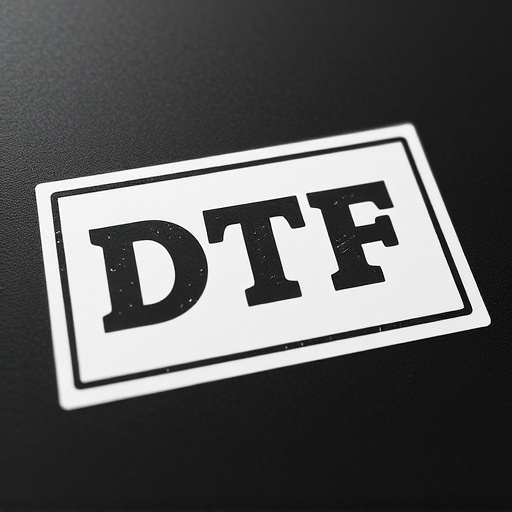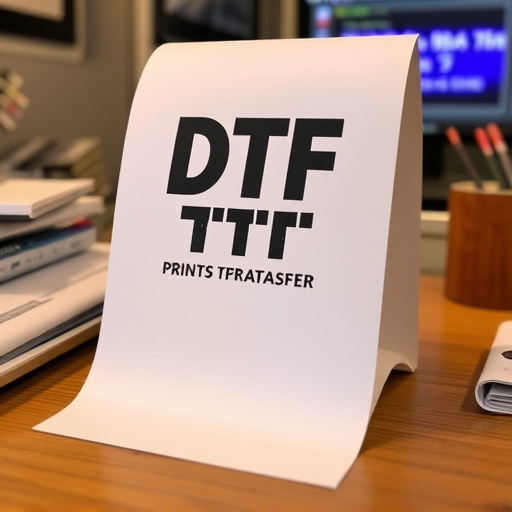Direct-to-film (DTF) transfer printing is a cutting-edge method for creating high-quality, vibrant prints on various surfaces. It involves skipping traditional plate-based printing and directly transferring ink from the print head to materials like fabric, paper, or wood. Key steps include precise surface preparation, ink application with specialized equipment, and curing with heat or UV light. Preparing artwork in compatible formats (SVG, PNG) at 300 DPI and cleaning lines ensures excellent DTF prints. Setting up the workspace, loading film correctly, and using high-resolution files are crucial for seamless printing. The process includes creating a mask, printing on transparent/white film, cutting out designs, drying ink, removing protective film, applying heat, and finishing to enhance durability. Proper care and adjustments can overcome challenges like misalignment and print quality issues, making DTF an effective method for diverse applications.
Discover the art of creating stunning direct-to-film (DTF) prints with our comprehensive guide. From understanding the DTF transfer process to mastering post-print care, this step-by-step journey will empower you to produce high-quality DTF prints. Learn how to prepare your artwork, set up your machine, and execute the transfer perfectly. Explore common challenges and troubleshooting tips to ensure every print is a masterpiece. Elevate your creative game with the magic of DTF Transfer!
- Understanding Direct-to-Film (DTF) Transfer: A Brief Overview
- Preparing Your Artwork for DTF Printing
- Setting Up the DTF Print Machine and Materials
- The Step-by-Step DTF Transfer Process
- Post-Print Care and Finishing Touches for DTF Prints
- Common Challenges and Troubleshooting Tips for DTF Transfers
Understanding Direct-to-Film (DTF) Transfer: A Brief Overview

Direct-to-film (DTF) transfer is a printing process that allows for high-quality reproduction of images and designs directly onto various media, such as fabric, paper, or wood. Unlike traditional printing methods that use separate plates for each color, DTF employs a unique technique where the ink is transferred directly from the print head to the surface without any intermediate rollers or plates. This method offers several advantages, including vibrant colors, fine detail reproduction, and faster production times.
DTF prints are particularly popular in industries like textiles, signage, and promotional products due to their ability to produce rich, durable results on a wide range of materials. The process involves preparing the surface, applying a thin layer of ink using specialized equipment, and then curing the ink with heat or UV light to ensure it adheres permanently to the substrate. Understanding these fundamental steps is crucial for achieving exceptional DTF transfer results.
Preparing Your Artwork for DTF Printing

Preparing your artwork for DTF (Direct-to-Film) printing is a crucial step to ensure the final prints are of high quality and accurately represent your design. First, ensure your artwork is in a compatible file format, such as SVG or PNG, and has the correct dimensions for the desired print size. This involves scaling and cropping your image to match the DTF transfer’s specifications, which can vary depending on the manufacturer.
Next, focus on resolution—a sharp, crisp image with adequate detail is essential. A minimum resolution of 300 DPI (dots per inch) is recommended for optimal results. Additionally, check for any background elements or unnecessary details that might obscure the design when printed. Simple, clean lines and a solid background color work best for DTF transfers, allowing the intricate details of your artwork to shine through.
Setting Up the DTF Print Machine and Materials

To begin using a direct-to-film (DTF) print machine, the first step is to meticulously set up your workspace and gather all necessary materials. This involves ensuring your DTF transfer film is properly fed into the printer, aligning it correctly according to the manufacturer’s guidelines. Next, prepare your design files by ensuring they are in a compatible format and resolution for DTF printing. High-quality designs with crisp lines and robust colors will yield the best results.
Once your workspace is prepared and materials organized, load the blank film into the printer. Ensure the print head is clean and free from debris to prevent smudging or inconsistent transfers. With the right setup, you’re now ready to start printing your DTF transfers, offering a seamless and direct way to create custom prints on various surfaces for a variety of applications.
The Step-by-Step DTF Transfer Process

The process of applying a DTF (Direct-to-Film) Transfer is a precise art that allows for high-quality prints directly onto various surfaces, from fabric to wood. Here’s a breakdown of the step-by-step procedure:
1. Preparation: Start by preparing your design file, ensuring it’s in the correct format (often PNG or JPEG) and resolution for printing. Use specialized DTF transfer software to create a mask that outlines the design elements you want to print. This ensures precise placement during the transfer process. Next, select your desired surface—the smoothness and porosity play a role in achieving optimal print quality.
2. Printing: Load your prepared film (often a transparent or white material) into the printer, ensuring proper alignment. Print the design onto the film using high-resolution settings. The ink should be cured according to the manufacturer’s instructions before proceeding. Once printed, carefully cut out the design from the film, leaving no residual borders.
Post-Print Care and Finishing Touches for DTF Prints

After completing the DTF printing process, proper post-print care is essential to ensure the longevity and quality of your prints. The first step in this process is allowing the ink to dry completely. Direct-to-film transfers can be sensitive during this initial stage, so it’s crucial not to handle or touch the print until the ink has set. A gentle breeze from a fan can aid in accelerating the drying process without causing smudging or warping.
Once dried, carefully remove the protective film from the DTF transfer. This is a delicate step that requires precision to avoid damaging the design. After removing the backing, apply heat (using an iron or heat press) to activate the adhesive side of the transfer and secure it to your desired substrate—be it clothing, paper, or other materials compatible with DTF printing. Proper finishing techniques ensure that your DTF prints not only look vibrant but also withstand wear and tear, allowing you to enjoy the results of your creative efforts for years to come.
Common Challenges and Troubleshooting Tips for DTF Transfers

Direct-to-film (DTF) printing can be a rewarding way to create custom designs on various materials. However, as with any new technique, it comes with its share of challenges. Common issues include poor print quality, misalignment, and inconsistent adhesion to the substrate. Troubleshooting these problems often involves simple adjustments to your setup and printing process.
For optimal DTF transfers, ensure your printer is properly calibrated and maintained. Use high-quality DTF inks and media to achieve better results. Before printing, clean the film and printing surface thoroughly to eliminate any debris or residues. Additionally, adjust your print settings carefully; correct color profiles and resolution can significantly impact final output quality. If misalignment is an issue, try using alignment guides or marks on both the film and substrate for a more precise placement.














